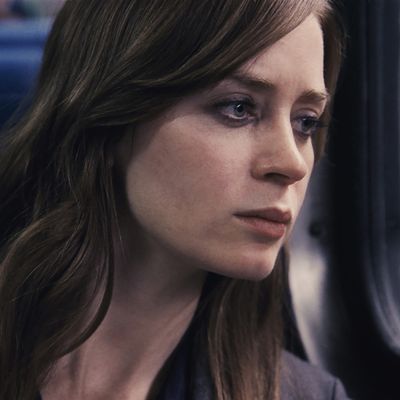
Leaving the screening of the mystery-thriller The Girl on the Train, I heard a young woman say to her companion, “That was really good.” I found that fascinating, as I would if someone had said, “It would be fun to slide under a port-a-potty and just, you know, experience the moistness and the smell,” or, “Donald Trump has great hair.” Movies take different forms in different heads and I’d have happily traded the good one in that woman’s for the dud in mine. I got depressed early, when I realized I’d be spending two hours in the hands of people who didn’t know how to tell a story. But it’s possible that the director, Tate Taylor (The Help), thought that he was making a serious film about the female mind in extremis and that conventional suspense techniques were beneath him. Which is fine, but the train still has to move.
Paula Hawkins’s novel — a publishing phenomenon — isn’t much to write home about either. Say what you will about a similar phenomenon, Gone Girl; that book’s author, Gillian Flynn, sprung her traps with cunning, and there was enough twisted psychology to keep you arguing for weeks. Hawkins’s book is a tease with a lousy punch line. What grabs you is the setup and the theme. The protagonist and sometime narrator, Rachel, went downhill after learning she couldn’t bear children. She lost her looks, her job, her husband, her home, and her ability to function without alcohol. Every day, she gazes through the window of a Hudson River train. She sees her old house, where her husband lives with the woman he left her for and their baby daughter. And she sees, in a house on the same block, a madly attractive, sexually avid couple onto whom she projects her deepest longings. But Rachel isn’t the only narrator. When we get into the heads of the other two women — Megan (the glamour girl) and Anna (the new wife) — we see they have the same envy of other women’s lives. But without giving anything away … well, anything I say would give something away. The point is that the resolution dodges all the most provocative questions.
Rachel is a certainly a plum role for an actress: a drunken, dipsomaniacal, boozy lush with an alcohol problem. (It’s about that subtle.) In the novel, Rachel has let her appearance go and become virtually invisible to men, but the film gives us the ever-visible Emily Blunt. Her skin is made-up to look blotchy from drink, her body is buried in shapeless clothes, and she wanders, rudderless, like a bag lady. But in movies, bone structure is destiny, and Blunt will somehow always suggest the taut physique she showed off in Edge of Tomorrow. She’s excellent, as always. (She can be astonishing even in movies as poor as The Huntsman: Winter’s War.) But Taylor brings his camera too close and, for the first time, you can see Blunt acting. Of course, he’s in all the actresses’ faces. Your nostrils twitch from the smell of so many red herrings.
I respect the screenwriter, Erin Cressida Wilson, for taking a shot at replicating the novel’s three perspectives with handy inter-titles. But that doesn’t work very well onscreen, where point of view can be passed more fluidly, and Taylor seems hobbled. He doesn’t smooth the transitions out and make the women’s inner lives seem connected. He just clunks along randomly, and Rachel’s emerging memories — done in arty, flickering slow-motion — confuse instead of clarifying the action. Taylor does what no one has ever done: make you tired of looking at Blunt. Even though pathetically drunk leading ladies are relatively rare in movies (the best was Jane Fonda in The Morning After, a mystery-thriller that also fell apart), the novelty wears off.
Although Haley Bennett is shot like a Victoria’s Secret model in her early scenes, her beauty is genuinely enigmatic: When she disappears, you don’t know (unless you’ve read the book) whether Rachel has beaten her to death in a drunken rage or if she’s pulling a Gone Girl. Rebecca Ferguson (who made a splash in the fifth Mission: Impossible film) is too much actress for the dullish role of the husband’s new spouse, but she goes beyond the lines and suggests a teeming inner life. The other actors are less fortunate. Allison Janney’s character — a cop — is written so atrociously that you have no clue how she came by her information or what she’s fishing for, if anything. Justin Theroux — who has given good and deeply eccentric performances — is remote to the point of dullness, and I had no clue (even after reading the book) what was supposed to be happening in the minds of Luke Evans as Megan’s excitable husband or Edgar Ramírez as her peculiarly intimate shrink.
Watching The Girl on the Train, I thought of the recently deceased director Curtis Hanson and one of his lesser works, 1987’s The Bedroom Window. It is, by most standards, a botched thriller, and Hanson was handicapped from the get-go with Steve Guttenberg as his lead. But there’s still something shapely in Hanson’s technique, in how he uses limited perspectives to heighten the fear and how he makes the victim (Isabelle Huppert) erotic and tantalizing in her mystery. A filmmaker has a feel for this kind of storytelling or doesn’t, and the people behind The Girl on the Train don’t.
But that young woman did say it was “really good.” Maybe she has a fetish for red herrings. The whole movie is a red herring.


